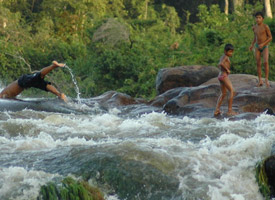




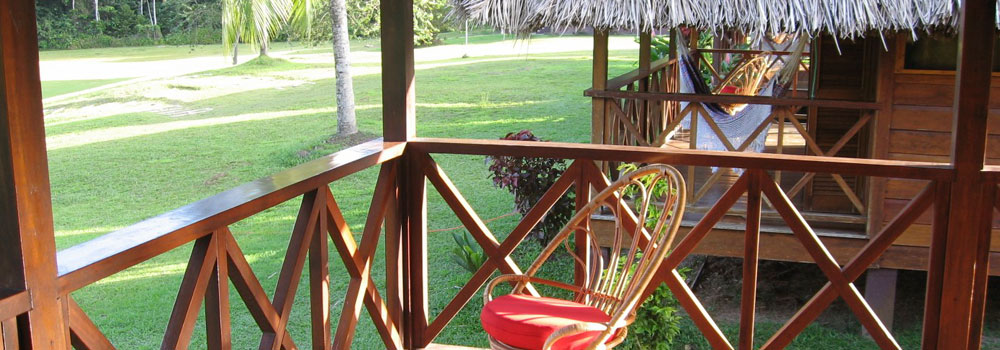
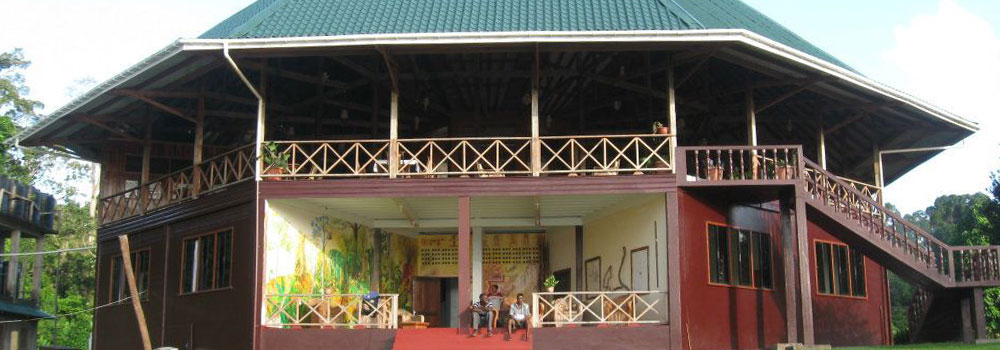
Be as adventurous as you want; stay as long as you like
No matter whether you’re young or old, a veteran or new traveller, adventurous or merely curious… we cater to a wide range of interests, abilities, and backgrounds at Iwokrama. We believe everyone can enjoy a stay in the rainforest that is as stimulating, enlightening, or as relaxing as you wish.
Activity Sampler

Iwokrama Canopy Walkway

Opened in November 2003, the 154 metre (505 ft.) Iwokrama Canopy Walkway offers a unique experience in the region and envelopes you in the jungle’s mid-level canopy through a series of suspension bridges and decks from heights of up to 30 metres (98 ft.).
If you visit at dusk or dawn, you’ll have the best chance to see birds like the Green Aracari, Scarlet Macaw, Guiana Toucanette or Channel-bill Toucan. Red Howler Monkeys may also be observed. Check out the epiphytes such as orchids and bromeliads, and look for the amazing parasitic Ficus plant as it engulfs another tree. Ask your guide to show you the endemic Greenheart tree, the Waramadan (endemic in Guyana only to the IwokramaForest) and the poisonous Aromata! You can also spend the night at the nearby satellite camp and experience the “art of survival” with our knowledgeable guides.
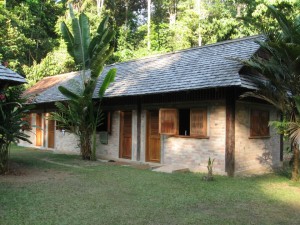
Atta Rainforest Lodge at the Canopy Walkway
There is also the opportunity to stay overnight at the Atta Rainforest Lodge, which is situated approximately 500 metres from the Canopy Walkway. The lodge is completely surrounded by tropical rainforest, offering a complete immersion in the rainforest experience. The main building is open sided with views across the gardens to the forest which is only 25 metres away. This has the bar, dining area and kitchen. The dining area is adjacent to the bar and encourages communal dining so that you can get to know your fellow adventurers. Trip departs Iwokrama River Lodge at 5am or 2pm.
The Canopy Walkway is operated by the CATS Parntership, a joint venture of Iwokrama, Rock View Lodge, Surama Eco-Lodge, and Wilderness Explorers.
Chat with us now!
Use the tab at the bottom of this window to talk an Iwokrama travel expert!


The Prince Charles Nature Trail is located on the southern boundary of the Iwokrama forest and was created and named in honour of the Prince’s visit to this area in 2000. Here he signed the agreement to become Iwokrama’s Royal Patron under a towering Brazilian cedar. An 800 metre walk will take you through beautifully varied forest that connects with the 400 metre long Cock-of- the-Rock trail to form a loop. On the latter trail you will stop to investigate an active leak of the famous Guianan Cock-of- the-Rock with its luminous orange balls of feathers display among the boulder-strewn forested hillside which surely would be the highlight of the trip.


Just imagine yourself cruising on the Essequibo River through the black of night, maybe lit only by a pale moon. Your guide shines the spotlight and there it is… the red-eye glare of the Black Caiman! Frequently and closely seen lying on the river banks, the world’s largest of the alligator family grows to 6 meters (20ft.) long. A boat ride at night may also introduce you to other nocturnal creatures such as Tree Boas, Pacas, Nightjars, and Hula tree frogs..


This early morning or dusk activity involves taking a drive along the Iwokrama Rainforest passage in search of wildlife. The Iwokrama Forest is rapidly gaining an international reputation for its healthy Jaguar populations that seem not to be troubled by the appearance of curious humans. No promises but many have been lucky.

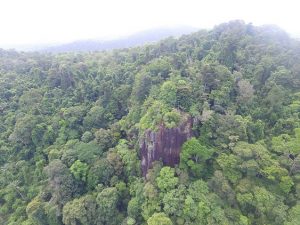
A trip to Iwokrama is not complete without hike to the top of Turtle Mountain. Take a 30-40 minute boat journey downriver and then hike the 2 mile trail up to 300 metre (950ft) summit for a stunning jungle vista punctuated by the powerful Essequibo River snaking through the forest. Numerous bird species can be spotted on the lower trail including the Red-and- Black Grosbeak, Yellow-billed Jacamar, and Brown-bellied Antwren. The journey may also reward you with sightings of monkeys such as Red Howlers, Wedge-capped Capuchins and Black Spiders, as well as Agoutis and Deer. For those of you who may find the trip to Turtle Mountain too strenuous, continue on the boat ride further downstream to a section of flooded várzea forest known as the Stanley Lakes. Here youtraverse through a maze of small channels and oxbow lakes by boat as they pass through a palm-rich forest which is largely inaccessible by foot. You are likely to see river turtles as well as bird species such as Anhingas and Ospreys and the (very) occasional Harpy Eagle!

The wonderful opportunity to see the diversity of birds in the Iwokrama Forest is ideal for anyone from the serious ornithologist to the casual naturalist. With over 500 species of birds in the Forest, bird watchers are sure to be rewarded! The Capuchinbird, Purple Crimson Topaz (largest hummingbird), Guianan Red-Cotinga, Cock of the Rock, and the rare Rufous-winged Ground Cuckoo are just a small sample of the birds you might see when visiting Iwokrama.
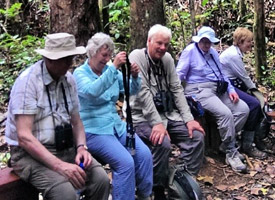
 Explore one of the nearby wildlife trails near the Field Station with an experienced Iwokrama Guide. Ask your guide about the Mora, Soft Wallaba and Wamara trees and the Screaming Piha, the Grey Chinned Hermit, and the Black-necked Aracari.You might even spot Howler Monkeys or a Sloth. After dinner, take a nocturnal guided nature walk from the Field Station; things to look out for are nocturnal creatures such as Boas, Pacas, Nightjars, and Hula tree frogs, bats and many other animals of the night.
Explore one of the nearby wildlife trails near the Field Station with an experienced Iwokrama Guide. Ask your guide about the Mora, Soft Wallaba and Wamara trees and the Screaming Piha, the Grey Chinned Hermit, and the Black-necked Aracari.You might even spot Howler Monkeys or a Sloth. After dinner, take a nocturnal guided nature walk from the Field Station; things to look out for are nocturnal creatures such as Boas, Pacas, Nightjars, and Hula tree frogs, bats and many other animals of the night.
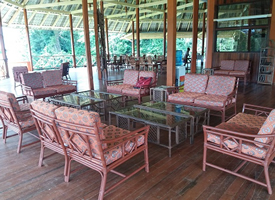
 You may want to spend a portion of your adventure simply enjoying the peace and quiet of a pristine forest environment or taking advantage of the amenities at the River Lodge. You can enjoy the sounds and sights of birds and monkeys or reflect upon the dark and mysterious EssequiboRiver. Take a nap or read in one of the hammocks. There is also a small but expanding reference library and a tourism office with complimentary internet access.
You may want to spend a portion of your adventure simply enjoying the peace and quiet of a pristine forest environment or taking advantage of the amenities at the River Lodge. You can enjoy the sounds and sights of birds and monkeys or reflect upon the dark and mysterious EssequiboRiver. Take a nap or read in one of the hammocks. There is also a small but expanding reference library and a tourism office with complimentary internet access.
Still Looking For More?
We can build a customized tour and activity package designed just for you. Contact us to find out what’s possible!
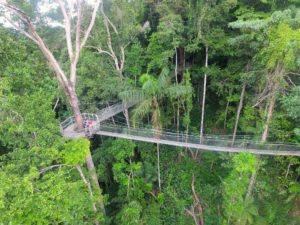



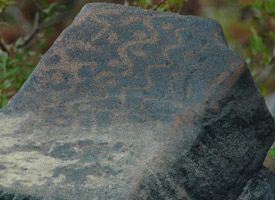
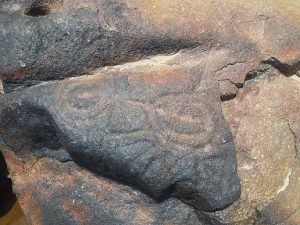
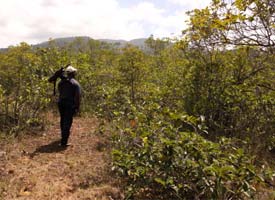
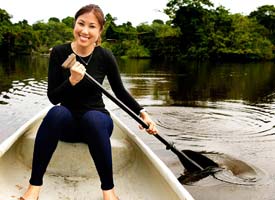
 For a small rental fee enjoy a leisurely canoe ride on your own along frontage of the River Lodge, under the watchful eyes of one of the guides.
For a small rental fee enjoy a leisurely canoe ride on your own along frontage of the River Lodge, under the watchful eyes of one of the guides.